By JULIE MINDA
This type of employee volunteerism didn't happen widely pre-pandemic
Prior to the COVID-19 pandemic, Beth Keehn never would have dreamed she'd be assisting in clinical units at Mercy Health — St. Rita's Medical Center in Lima, Ohio. But the director of community and government affairs for Mercy Health — Lima wrote in a December blogpost, "In this moment, what my community needs from me most is to don the scrubs and do whatever I can for those who need us most."
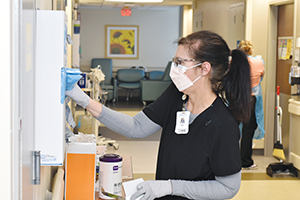
Mercy talent selection manager Katie Horton stocks supplies at Mercy Hospital South in suburban St. Louis. She volunteered for nonclinical support tasks to ease the COVID-related pressure on colleagues, including those giving direct patient care on COVID units.
Joe Poelker/Mercy Hospital South
Keehn is among the many Mercy Health associates who have been stepping up when their system's hospitals ask for employee volunteers to provide nonclinical assistance to units and services overstretched during COVID-19 caseload surges. Mercy Health is part of Bon Secours Mercy Health.
Late last year, in responding to such a call, Keehn filled in as a patient sitter, remaining in the room of a middle-aged man rendered seriously ill by the virus.
She held his hand, listened as he spoke — though she said his words were mostly jumbled and nonsensical — and "tried to assure him he would be OK and that we were doing everything we could to help him. And when he got very scared and confused and tried to pull out his oxygen, I had to convince him to let it be," she said in the blogpost.
Many hospitals across the U.S. have been entreating employees — including those without a clinical background — to come to the aid of units strained to capacity. Ministry associates who are coordinating the volunteerism said the arrangement has given clinicians desperately needed support. Employees who volunteered for nonclinical tasks said they came away with a lived understanding of their hospitals' mission and a deeper appreciation for the commitment of clinical staff. They bonded with colleagues they otherwise may have never met.
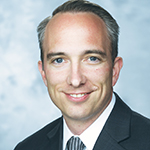
Till
Surge-driven
Greg Till, Providence St. Joseph Health chief people officer, said that while some type of role-sharing is fairly typical at rural facilities and some long-term care sites, having large numbers of employees volunteering for responsibilities far outside of their own wheelhouse is unusual in most hospitals.
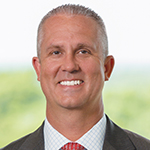
Bradford
Jeremy Bradford, president of SSM Health Good Samaritan Hospital–Mount Vernon, Illinois, said leadership team members and others have always stepped in to aid colleagues. Before the pandemic senior executives did stints as patient safety sitters, for instance. But the pandemic prompted SSM Health to create a formal volunteer process for staffers.
He added that it's not just executives and administrators pitching in at his hospital and across the system. Any SSM Health employee can offer to fill a shift in a nonclinical job.
According to Betty Jo Rocchio, senior vice president and chief nursing officer of Chesterfield, Missouri-based Mercy, the exigencies of the pandemic have spurred health care providers to use approaches never widely tried before. Surges of the virus — particularly during the omicron wave — meant record admissions, even as clinicians themselves got infected and had to go home sick, and that left many units very shorthanded. "Given the situation we face, we're asking co-workers who normally aren't involved in patient care to help in nonclinical roles, giving our clinical teams more time with patients," she was quoted as saying in a January press release from Mercy.
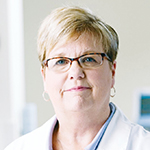
Eckhardt
Amplifying the staff shortages was the lack of outside volunteers, noted Monica Eckhardt, chief nursing officer for Trinity Health Mid-Atlantic. Hospitals have not been allowing outside volunteers to work during surges. But many hospital administrators added that a lot of the tasks being done by staff would not have been assigned to non-staff volunteers.
Till said that it became obvious early in the pandemic that not every Providence facility was going to be hit with surges at the same time — the system has operations in seven Western states — and that spurred the idea for labor sharing. He said it helps when government agencies relax existing barriers to labor sharing, to ensure hospitals can staff effectively.
Cross-training
It is a complex task to identify employees willing, able and available to help on short notice; match them with units in need of extra hands; and ensure the volunteers and other staff arrive equipped for success.
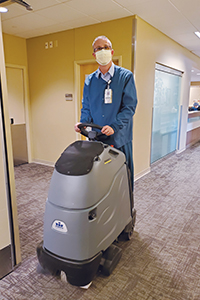
Jeremy Bradford, president of SSM Health Good Samaritan Hospital — Mount Vernon, Illinois, operates a carpet cleaning machine at the hospital as he pitches in to support the hospital's environmental services department.
Eckhardt said as part of the 88-hospital Trinity Health system's pre-pandemic disaster planning it had set up protocols and developed a tool kit for hospital units to use if and when labor sharing became necessary. Under the approach, unit staff train clinicians and other staff from different units and departments to prepare them to step up in times of short staffing.
During the pandemic, Trinity Health facilities stood up systems for assessing the skill sets, interests and availability of colleagues to work in other units. Individuals who received training were eligible to volunteer to do jobs other than the one they were hired for.
Eckhardt said COVID units were most in need of help, and staff volunteers changed linens; delivered patient meal trays, supplies and pharmaceuticals; and answered phones.
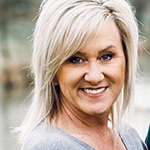
DeSpain
Jodi DeSpain is a nurse manager who helps handle staffing and other needs for PeaceHealth Southwest Medical Center in Vancouver, Washington. She said the resource center where she works created a labor pool that centralizes coordination of staff to assist with everything from cleaning for infection control, to feeding and walking patients.
All employees get thorough instructions on how to do the tasks they are unaccustomed to performing. Some have clinical backgrounds, some do not. Many colleagues from the PeaceHealth system office are regulars in the temporary labor pool. DeSpain said she has seen many salaried system office employees work their usual 40-hour week and then volunteer a day on the weekend. "It's really appreciated and valued" by the clinicians in the units, she said.
Turkey link
Keehn of Mercy Health — Lima said St. Rita's has had the highest patient censuses in its history during COVID surges. During one big surge, the hospital repurposed a sign-up system for a Thanksgiving event to solicit volunteers and then plug them into open assignments.
Both clinical and nonclinical colleagues have signed up to be patient sitters, to restock supplies, to answer call lights — anything that can free up exhausted clinical team members.
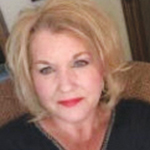
Baily
As market foundation board coordinator for St. Rita's, Mary Ann Bailey had not spent much time on patient floors pre-COVID. But since volunteering about a dozen times for temporary shifts assisting in nursing units, she's felt more a part of the hospital's work.
Till said Providence invited caregivers to fill out a survey listing their skill sets and certifications and how they'd be willing to help, if called upon.
The facilities use that information to solicit volunteers for both clinical and nonclinical temporary assignments. If nurses pick up open clinical shifts, they are paid for that work; but if volunteers perform nonclinical tasks on a temporary and/or emergency basis, they generally do so without remuneration.
Switching gears
Much of the volunteerism is aimed at offloading administrative tasks from nurses, so they can focus on clinical work. Till himself was a volunteer — he worked in vaccine clinics, helping to log people in, taking temperatures and running supplies. "In these times, it's all hands on deck," he said.
Mercy hospitals also asked salaried employees to sign up to stock supplies; transport patients; and assist patients with bathing, feeding, grooming and toileting. "It's no surprise with Mercy's culture that hospital administrators are pushing wheelchairs, accountants are emptying trash cans and marketing professionals are serving meals," said Steve Mackin in a release about associates pitching in to help their colleagues. On April 6, Mackin becomes president and chief executive of the system.
The executives said that the staff volunteerism during the health emergency has lessons for the post-pandemic era.
Mercy Health's Keehn said, "We have always had a culture of 'chipping in' and working together. But, I think this has shifted our understanding of what is possible and just how much we can lean on each other when needed. While we sure hope we can remain in normal operations from here on out, we now know we can switch gears quickly and do whatever needs done for the community."
Bradford of SSM Health's Good Samaritan said: "We came together as a work family and are rising to the occasion. We're all working together to ensure our patients are well taken care of. It's brought us all closer together as a work family, and we have a lot to be proud of."
Mercy has produced this video about labor sharing among its associates.